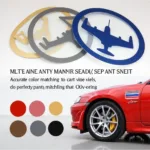Cracked car paint is an unsightly problem that can diminish your car’s aesthetic appeal and, if left untreated, lead to more serious issues like rust. This guide provides a deep dive into the causes, prevention, and repair of cracked car paint, equipping you with the knowledge to restore your car’s finish.
Understanding the reasons behind cracked paint is the first step towards effective repair. Improper paint application, such as applying a thick coat or failing to prepare the surface correctly, can lead to cracking. Environmental factors like harsh weather conditions, prolonged sun exposure, and even bird droppings can also contribute to this issue. Learn how to effectively address this problem and prevent future occurrences. Let’s dive right in. how to repair cracked car paint offers a practical step-by-step guide.
Identifying the Types of Cracked Car Paint
Different types of cracks require different repair approaches. Identifying the specific type of cracking on your car is crucial for selecting the appropriate repair method.
Stress Cracks
Stress cracks, often appearing as hairline fractures, are typically caused by impacts or flexing of the car’s body panels. These cracks usually appear in areas subjected to stress, such as around door hinges or bumpers.
Micro-Cracking/Crazing
Micro-cracking, also known as crazing, presents as a network of fine cracks, often resembling spiderwebs. This is usually a result of UV damage and weathering, especially on older vehicles.
Chip Cracking
Chips and scratches, if left unaddressed, can become entry points for moisture, leading to cracking around the affected area.
How to Repair Cracked Car Paint
Repairing cracked car paint involves several steps, from assessing the damage to applying the final touches.
Assessing the Damage
Before starting any repair, carefully examine the extent of the cracking. This assessment will determine the necessary tools and materials, as well as the complexity of the repair process. For minor cracks, a simple touch-up might suffice, while more extensive damage may require professional attention.
Preparing the Surface
Clean the affected area thoroughly with soap and water, then degrease with a suitable solvent. Sanding the cracked area with fine-grit sandpaper creates a smooth surface for the new paint to adhere to. For deeper cracks, priming might be necessary to ensure proper adhesion and prevent future cracking. repair cracked paint car bumper provides specific guidance on repairing bumpers.
Applying the Paint
Apply thin, even coats of automotive paint, allowing each coat to dry completely before applying the next. Avoid applying thick coats, as this can lead to further cracking.
Finishing Touches
Once the paint has dried, lightly sand the area with very fine-grit sandpaper to blend the repair seamlessly with the surrounding paintwork. Applying a clear coat sealant protects the repair and restores the car’s original shine. how to repair cracked paint on car explains the entire repair process in detail.
Preventing Cracked Car Paint
Preventing cracked car paint is easier than repairing it. Regular washing and waxing protect the paint from environmental damage. Parking your car in a garage or under a car cover shields it from harsh sunlight and weather elements.
“Preventing cracked paint is about proactive care. Regular waxing creates a protective barrier against the elements, significantly reducing the risk of damage,” says John Miller, Automotive Paint Specialist at Miller’s Auto Body.
DIY vs. Professional Repair
While minor cracks can often be repaired with DIY methods, more extensive damage often requires professional expertise. Professional repair ensures a high-quality finish and addresses any underlying issues contributing to the cracking. For cracked paint on your car bumper, consider repair cracked paint on car bumper for valuable information.
Conclusion
Repairing cracked car paint is essential for maintaining your car’s appearance and preventing further damage. By understanding the causes and taking appropriate preventive measures, you can keep your car looking its best for years to come. Remember, addressing cracked paint promptly can save you from more costly repairs down the line. cracked paint on car repair offers more insights into this topic.
“Addressing cracked paint early is crucial. Small cracks can quickly escalate into larger, more complex problems if neglected,” advises Sarah Chen, Lead Technician at Chen’s Auto Repair.
FAQ
- What causes car paint to crack? Various factors contribute to cracked car paint, including improper paint application, environmental factors like UV exposure and harsh weather, and impacts.
- Can I repair cracked car paint myself? Minor cracks can often be repaired with DIY methods, but more significant damage usually requires professional repair.
- How can I prevent car paint from cracking? Regular washing, waxing, and protecting your car from the elements can help prevent cracked paint.
- What type of paint should I use for touch-ups? Use automotive paint specifically designed for your car’s make and model to ensure a perfect match.
- How long does it take to repair cracked car paint? The repair time varies depending on the extent of the damage, ranging from a few hours for minor cracks to several days for more extensive repairs.
- Is it necessary to prime before repainting a cracked area? Priming is often necessary, especially for deeper cracks, to ensure proper adhesion of the new paint.
- What are the signs of cracked car paint? Signs include hairline fractures, spiderweb-like patterns, and cracks originating from chips or scratches.
Need further assistance? Contact us via WhatsApp: +1(641)206-8880, or Email: [email protected]. Our customer support team is available 24/7.


